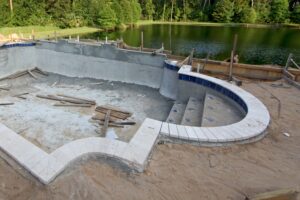by Paige Jessup, Climate Resilience Intern
Pool and hot tubs are wonderful for recreational activity, aerobic activity and physical therapy, relaxation, and social gatherings. However, they may not be so wonderful for your local freshwater. Pools and hot tubs contain chlorine, bromide, salt, and algaecides which can be dangerous to the adjacent environment. Pool and hot tub water that is improperly discharged or improperly treated before being released can end up in different water bodies, negatively affecting the water quality and therefore the different aquatic organisms and vegetation that live there.
Chlorine Based Pools
According to Parveen et al. (2022), upon discharge into the aquatic environment, chlorine based disinfectants can create lethal living conditions for aquatic life. The accumulation of chlorine in an aquatic environment may lead to chronic adverse effects on ecosystems and the species that live there, including planktons, fish, and vegetation (Pignata et al. 2012). In oxygen deprived lakes, algae are known to be sensitive to chlorine. The enrichment of nutrients into lakes leads to harmful algal blooms and the low or depleted oxygen in a water body due to high nutrient loads (Yan et al., 2018). This can lead to what is known as “dead zones” in lakes and other water bodies, meaning they cannot sustain life and causes fish, plants and other aquatic life to die off.
Pool chemicals can also affect the terrestrial ecosystems. For example, chlorine from hot tub or pool water disposal can be easily absorbed by soil and cannot be easily broken down. This means that chloride flux in a soil mass is driven only by water flow (Parveen et al., 2022). Another impact of chlorine on an adjacent freshwater ecosystem is its toxicity to plants which usually results in death of the whole plant, thereby affecting the wildlife that rely on them for food.

Saltwater Based Pools
The common alternative to chlorine based pool cleaners are saltwater pools. People often choose this alternative because there are fewer harsh chemicals, and there is less and cheaper maintenance. However, saltwater still has effects on freshwater bodies. Elevated salt concentrations can impair aquatic flora, lead to widespread fish die-offs, and make Canada’s freshwater areas hostile for many species to live in. The implications extend beyond individual organisms; heightened salinity can reconfigure food webs and perturb natural cycles (Clavier, 2024). High salt levels can also degrade soil quality and the ability of plants to thrive in it (Bauske et al., 1993). This has consequences for wildlife who use these vegetation areas for food, shelter, and shade.

What can you do?
One great step is sharing Watersheds Canada’s new hot tub and pool education toolkit with your family, neighbours, and waterfront association. Sharing helpful information about the harmful effects of improper disposal of hot tub and pool water can lead to the adoption of best practices. Be sure not to drain the water improperly. Swimming pools can hold up to 25,000 gallons of water, and this impact is greatly magnified as the number of pools and hot tubs increases along a road or lake. It is important we all work together to protect the health of our freshwater communities.
Watersheds Canada is initiating an education awareness campaign to protect our freshwater ecosystems from hot tub and pool pollution. Your action could be the ripple effect needed to spark change! Share this education campaign with those in your network and community as we all join hands against pollution to our freshwater areas.
References
Bauske, E. M., Goetsch, H. M., & Blume, H. P. (1993). Effect of sodium chloride on soil physical properties and their functions. Ecological Modelling, 66(1-2), 1-15.
Clavier, A. (2024). Are Canada’s lakes becoming salty? Watersheds Canada. Retrieved from https://watersheds.ca/are-canadas-lakes-becoming-salty/
Parveen, N., Chowdhury, S., & Goel, S. (2022). Environmental impacts of the widespread use of chlorine-based disinfectants during the COVID-19 pandemic. Environmental science and pollution research international, 29(57), 85742–85760. https://doi.org/10.1007/s11356-021-18316-2
Pignata C, Fea E, Rovere R, Degan R, Lorenzi E, de Ceglia M, Schilirò T, Gilli G. (2012). Chlorination in a wastewater treatment plant: acute toxicity effects of the effluent and of the recipient water body. Environ Monit Assess 184:2091–2103. https://doi.org/10.1007/s10661-011-2102-y
Yan, Z., Wang, Y., Wu, D., & Xia, B. (2018). Exploration of an urban lake management model to simulate chlorine interference based on the ecological relationships among aquatic species. Scientific Reports (Nature”Publisher Group), 8, 1-14. doi:https://doi.org/10.1038/s41598-018-26634-8
This blog is part of an education toolkit generously funded by:


Thanks for your work…I’m looking for practical solutions to advise though, you mention improper disposal, … what proper or safe methods of disposal are there ? is it safe to pump down a concrete street and into a sewer in town of Muskoka ? should land owners send through their drains into municipal water systems or into their septic beds ? .